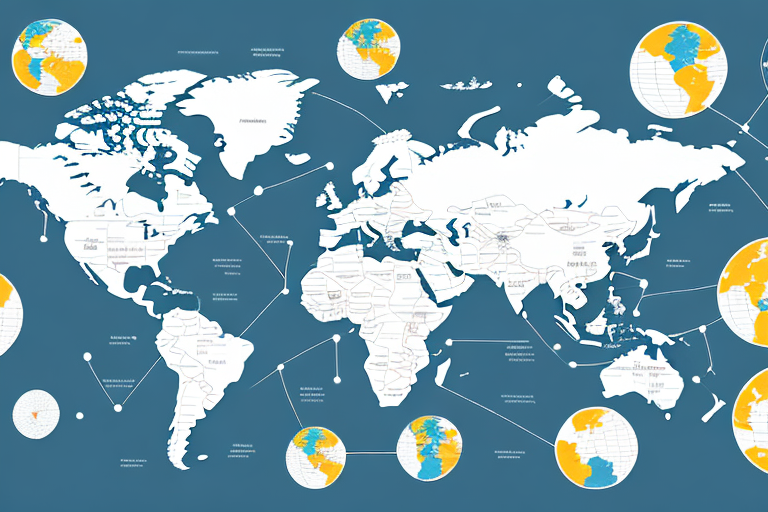Understanding UPS Shipping Rates
Are you tired of unexpected high UPS shipping rates? Do you want to gain a better understanding of what factors into calculating these rates? Look no further than this comprehensive guide to UPS shipping rates on YouTube. In this article, we will break down everything you need to know about UPS shipping rates, including the different types of rates, how they are calculated, and tips for saving money.
Why You Need to Understand UPS Shipping Rates
Shipping rates are a critical factor to consider when sending packages, especially for businesses that rely on shipping to deliver their products. Understanding UPS shipping rates allows you to plan your shipping expenses more accurately and make informed decisions about which UPS services are best for your needs.
Additionally, understanding UPS shipping rates can help you save money on shipping costs. By knowing the different factors that affect shipping rates, such as package weight, dimensions, and destination, you can adjust your shipping strategy to minimize costs. For example, you may choose to use a different UPS service or adjust your packaging to reduce the weight or size of your packages.
A Brief Overview of UPS Shipping Rates
UPS shipping rates are determined by various factors, including package size and weight, destination, and shipping speed. UPS offers several types of shipping rates, including daily rates, retail rates, and customized rates for frequent shippers.
One of the most important factors that determine UPS shipping rates is the package size and weight. The larger and heavier the package, the more expensive the shipping rate will be. Additionally, the destination of the package plays a significant role in determining the shipping rate. Shipping to a remote location or an international destination typically costs more than shipping within the same country.
UPS offers various shipping speeds to accommodate different needs. For urgent shipments, customers can choose from UPS Next Day Air, UPS 2nd Day Air, and UPS 3 Day Select. For less urgent shipments, UPS Ground is a more affordable option. Customers can also add additional services, such as signature confirmation or insurance, for an extra fee.
How UPS Shipping Rates are Calculated
The most significant factors in calculating UPS shipping rates are package weight and size. The heavier and larger the package, the higher the shipping rate. Additionally, shipping rates can vary depending on the distance a package needs to travel, with longer distances resulting in higher rates.
Another factor that can affect UPS shipping rates is the type of service selected. For example, expedited or overnight shipping typically costs more than standard ground shipping. Additionally, the destination country can impact shipping rates, with international shipping rates often being higher due to customs fees and other factors.
UPS provides various tools and resources to help customers estimate shipping rates, including online calculators and rate charts. By inputting package weight, size, and destination information, customers can get an idea of their shipping costs before sending their package.
Factors that Affect UPS Shipping Rates
- Package Weight and Size: Heavier and larger packages incur higher rates.
- Destination: Shipping to remote or international locations increases costs.
- Shipping Speed: Faster shipping options like overnight delivery cost more.
- Additional Services: Extra services such as insurance or signature confirmation add to the cost.
- Fuel Surcharges: Fluctuations in fuel prices can affect shipping rates.
- Residential Delivery Surcharges: Deliveries to residential addresses may incur additional fees.
Other considerations include the type of package being shipped. For example, hazardous materials or items requiring special handling may incur additional fees. Additionally, the destination country's customs regulations and taxes can impact the final shipping cost. It's important to research and understand all potential fees and regulations before shipping internationally.
Understanding the Different Types of UPS Shipping Rates
UPS offers various types of shipping rates to accommodate different business needs:
- Daily Rates: Available for frequent UPS users.
- Retail Rates: Designed for those who don't ship regularly.
- Customized Rates: Tailored for larger businesses with specific shipping needs.
UPS also offers different shipping services, such as ground, air, and international shipping. Ground shipping is typically the most cost-effective option for domestic shipments, while air shipping is faster but more expensive. International shipping rates vary depending on the destination country and the weight and size of the package. Additional services like insurance, tracking, and signature confirmation are available for an extra fee.
The Zone-Based Pricing System
The zone-based pricing system is a method UPS uses to calculate shipping rates based on the distance from the origin to the destination. The United States is divided into several zones, each with different shipping rates based on its proximity to the origin.
This system benefits both UPS and its customers. It allows UPS to efficiently allocate resources and manage shipping operations, while customers can accurately estimate shipping costs based on their location. Additionally, the zone-based pricing system incentivizes businesses to locate closer to their customers, reducing shipping costs and improving delivery times.
How to Find and Compare UPS Shipping Rates
Before shipping your package, it's essential to compare UPS shipping rates to find the most cost-effective option. You can use UPS's online rate calculator to estimate shipping costs and compare prices between different UPS services.
UPS shipping rates can vary depending on the weight and dimensions of your package, as well as the destination and shipping speed. To ensure you're getting the best rate:
- Optimize Packaging: Use smaller boxes or envelopes to reduce weight and size.
- Choose Slower Shipping: Opting for slower shipping speeds can result in lower rates.
- Check for Discounts: Look for available discounts or promotions, such as free shipping for orders over a certain amount or discounted rates for frequent shippers.
Tips for Saving Money on UPS Shipping Rates
- Ship During Non-Peak Times: Avoid peak seasons to take advantage of lower rates.
- Negotiate Rates: If you ship frequently, negotiate better rates with UPS.
- Optimize Packaging: Package items as compactly as possible without compromising safety to avoid extra fees.
- Use UPS's Online Tools: Compare rates and delivery times using UPS's online resources.
- Utilize Flat-Rate Boxes: For heavier items, flat-rate boxes can be more affordable than shipping by weight.
- Proper Labeling: Ensure accurate labeling to avoid delays or additional fees.
- Use Pickup Services: Save time and money by using UPS's pickup service instead of dropping off at a location.
How to Negotiate Better UPS Shipping Rates
If you ship frequently, you may be able to negotiate lower rates with UPS. Start by analyzing your shipping history to determine which services you use most often. Then, reach out to UPS and discuss your shipping needs to see if you qualify for customized pricing.
Another way to potentially lower your UPS shipping rates is to consider using alternative shipping methods. For example, UPS offers a service called SurePost, which collaborates with the United States Postal Service. This service can be a more cost-effective option for shipping lightweight packages.
Additionally, UPS may offer discounts for certain industries or businesses. If you are a non-profit organization or a small business, you may be eligible for discounted rates. Be sure to inquire about any potential discounts that may apply to your business.
Common Mistakes to Avoid When Using UPS Shipping Services
- Incorrect Address: Always double-check the recipient's address before shipping to prevent packages from being returned or lost in transit.
- Poor Packaging: Ensure items are packaged securely to avoid damage during transit.
- Ignoring Rates: Failing to compare rates can result in higher shipping costs than necessary.
- Not Utilizing Tools: Avoid not using UPS's online tools for rate calculation and tracking, which can help manage shipping more effectively.
Understanding Additional Fees and Surcharges
UPS charges additional fees and surcharges for various reasons, including residential deliveries, weekend deliveries, international shipments, and more. It's crucial to understand these additional charges to avoid surprises and accurately budget your shipping costs.
- Residential Delivery Fee: Applied when a package is delivered to a residential address instead of a commercial address. Even if you operate a business from home, UPS considers it a residential address and will apply the fee.
- Oversized Package Fee: Applied when a package exceeds UPS's maximum size or weight limits. Measure and weigh your packages accurately to avoid this fee.
- Fuel Surcharges: Fluctuating fuel prices can lead to varying surcharges on shipping rates.
- Customs Fees: For international shipments, customs regulations and taxes can impact the final shipping cost.
How to Handle Disputes Regarding UPS Shipping Rates
If you have a dispute over UPS shipping rates or services, contact UPS customer service to resolve the issue. You can also file a claim for lost or damaged packages through UPS's online claims system.
When contacting UPS customer service about a dispute, have all relevant information on hand, including the tracking number, shipping date, and any other pertinent details about the shipment. Additionally, understand UPS's shipping policies and rates, which can be found on their website or by speaking with a customer service representative.
Alternatives to Using UPS for Your Shipping Needs
If you're looking for alternative shipping options to UPS, consider carriers like USPS, FedEx, or DHL. Each of these carriers offers different shipping options and rates, so it's essential to compare prices and services before making a decision.
Another alternative is regional carriers, which specialize in specific regions and can often offer faster and more affordable shipping options than larger carriers like UPS. Examples of regional carriers include OnTrac, LaserShip, and Eastern Connection.
Conclusion: Mastering UPS Shipping Rates
Shipping rates can be a significant expense for businesses and individuals, but gaining a better understanding of UPS shipping rates can help you save money and make informed decisions about your shipping needs. Consider factors like package weight and size, destination, and shipping speed when estimating your shipping costs, and don't hesitate to negotiate better rates with UPS. With the knowledge gained from this guide, you can master UPS shipping rates with ease.
UPS offers various shipping options, such as ground, air, and international shipping, each with its own set of rates and delivery times. It's essential to choose the option that best fits your needs. Additionally, UPS provides tools and resources on their website to help you calculate shipping costs and track your packages in real-time.
Keep in mind that UPS shipping rates can fluctuate based on market conditions and fuel prices. Regularly review your shipping costs and adjust your shipping strategy accordingly. By staying informed and proactive, you can continue to save money and streamline your shipping process with UPS.




















